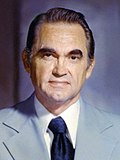November 5, 1968 | |||||||||||||||||||||||||||||||||||||
| Turnout | 49.9% (voting age) [1] | ||||||||||||||||||||||||||||||||||||
|---|---|---|---|---|---|---|---|---|---|---|---|---|---|---|---|---|---|---|---|---|---|---|---|---|---|---|---|---|---|---|---|---|---|---|---|---|---|
| |||||||||||||||||||||||||||||||||||||
| |||||||||||||||||||||||||||||||||||||
| |||||||||||||||||||||||||||||||||||||
| Elections in Alaska |
|---|
 |
The 1968 United States presidential election in Alaska took place on November 5, 1968, as part of the nationwide presidential election. Voters chose three representatives, or electors to the Electoral College, who voted for president and vice president.
Contents
- Results
- Boroughs and Census Areas that flipped from Democratic to Republican
- Analysis
- See also
- Notes
- References
Alaska was won by Richard Nixon (R-New York [a] ) with 45.3 percent of the popular vote against incumbent Vice President Hubert Humphrey (D-Minnesota) with 42.6 percent. [2] Nixon ultimately won the national vote as well, defeating Humphrey and becoming the next President. Former and future Governor George Wallace (D-Alabama) ran under the American Independent Party ticket, which favored continuing racial segregation within public schools in addition to most other areas of society throughout the Southern United States.
Wallace received over 12% of the vote in Alaska, unusually well for a state so far removed from his strongholds in the Deep South. [3] This would begin Alaska's reputation as a state where third party candidates of differing political persuasions do relatively well.
In Alaska, voters were more concerned with Alaska oriented issues rather than those seen in the continental United States. The 1968 elections held in Alaska had higher levels of turnout than previous elections when it was a state. [4]






